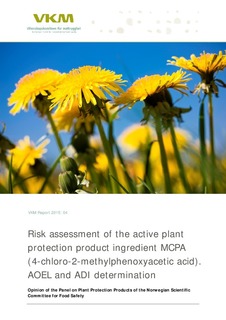| dc.contributor.author | Nilsen, Asbjørn Magne | |
| dc.contributor.author | Dirven, Hubert | |
| dc.contributor.author | Lyche, Jan Ludvig | |
| dc.contributor.author | Låg, Marit | |
| dc.contributor.author | Borgå, Katrine | |
| dc.contributor.author | Eklo, Ole Martin | |
| dc.contributor.author | Grung, Merete | |
| dc.contributor.author | Sverdrup, Line Emilie | |
| dc.contributor.author | Källqvist, Torsten | |
| dc.date.accessioned | 2017-11-03T12:12:51Z | |
| dc.date.available | 2017-11-03T12:12:51Z | |
| dc.date.created | 2017-10-31T08:51:13Z | |
| dc.date.issued | 2015 | |
| dc.identifier.isbn | 978-82-8259-158-4 | |
| dc.identifier.uri | http://hdl.handle.net/11250/2463973 | |
| dc.description.abstract | MCPA (4-chloro-2-methylphenoxyacetic acid) is the active ingredient in several registered herbicides. VKM concluded in 2006 that the effects observed in experiments with dogs were of little relevance to humans, and an AOEL value of 0.036 mg/kg bw/day was proposed, based on renal effects in a 90-day study in rats. The manufacturer is of the opinion that AOEL should be set to 0.11 mg/kg bw/day, and ADI to 0.05 mg/kg bw/day, based on the view that since a 90-day and 2-year study in rats were conducted in the same lab using the same rat strain, it is reasonable to eliminate effects which are not reproduced in both sets of data. The Norwegian Food Safety Authority has therefore requested VKM’s Panel for Plant Protection Products for an opinion on the determination of NOAEL values based on the 90- day and 2-year studies in rats, and consider if it is acceptable to use the manufacturer's approach for an overall consideration of the submitted studies. The Panel has discussed the findings in the two rat studies and concluded that it is not considered acceptable that individual studies separated by several years, in this case studies performed in 1985 and 1988, are taken together and data not reproduced in both sets eliminated. The Panel is still of the opinion that both AOEL and ADI for MCPA should be set to 0.036 mg/kg bw/day based on a NOAEL of 3.6 mg/kg bw/day (50 ppm) from assessment of the renal effects in the 90-day study in rats. The manufacturer has also requested a reconsideration of the present values for dermal absorption which was set by the Norwegian Food Safety Authority during the administrative review of the product MCPA 750 Liquid in 2013. VKM’s Panel on Plant Protection Products supports the conclusion of the Norwegian Food Safety Authority concerning the determination of values for dermal absorption of MCPA. This includes the consideration of remaining substance in skin after washing as part of the absorbed dose in the in vitro studies, and the use of the same experimental time period in the in vitro and in vivo experiments as a basis for the so-called “Triple-pack-approach” for determination of human dermal absorption. | nb_NO |
| dc.language.iso | eng | nb_NO |
| dc.publisher | Norwegian Scientific Committee for Food Safety (VKM) | nb_NO |
| dc.relation.ispartof | VKM Report | |
| dc.relation.ispartofseries | VKM Report; | |
| dc.relation.uri | https://vkm.no/download/18.2994e95b15cc545071614261/1498135449347/72ee69e92f.pdf | |
| dc.title | Risk assessment of the active plant protection product ingredient MCPA (4-chloro-2methylphenoxyacetic acid). AOEL and ADI determination. Opinion of the Panel on Plant Protection Products of the Norwegian Scientific Committee for Food Safety | nb_NO |
| dc.type | Research report | nb_NO |
| dc.description.version | publishedVersion | nb_NO |
| dc.source.pagenumber | 17 | nb_NO |
| dc.source.issue | 2015:04 | nb_NO |
| dc.identifier.cristin | 1509125 | |
| cristin.unitcode | 194,65,15,0 | |
| cristin.unitname | Institutt for klinisk og molekylær medisin | |
| cristin.ispublished | true | |
| cristin.fulltext | original | |
